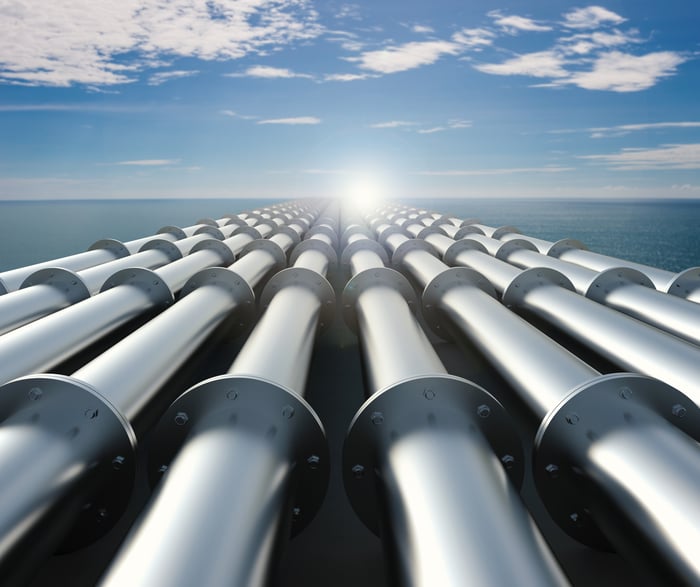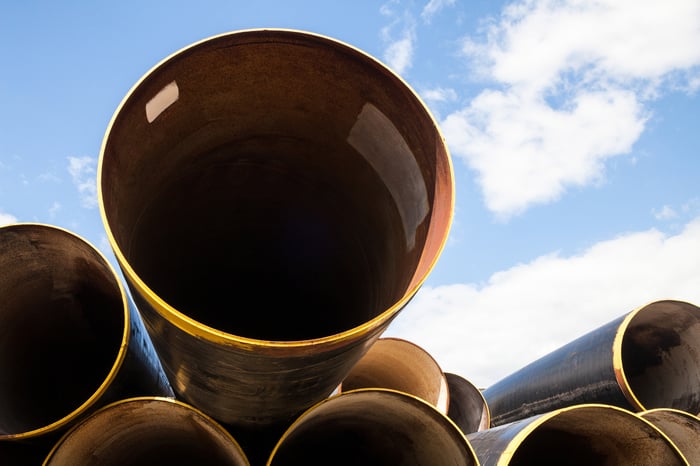Enbridge (ENB 0.68%) has grown at a healthy clip over the past couple of decades. In the 24 years from 1996 through 2019, the Canadian energy infrastructure giant increased its dividend at an 11% compound annual rate. That growth trend appears likely to continue since the company already has some growth visibility into the next decade. At the moment it has CA$10 billion Canadian dollars' ($7.5 billion) worth of expansion projects under construction that should come online between 2020 and 2023. Those projects help support Enbridge's view that it can grow its cash flow per share by an annual rate of 5% to 7% over the long term.
The company is working on adding even more expansions to its backlog to further increase its growth visibility well into the next decade. Here's a look at what Enbridge has coming down the pipeline.

Image source: Getty Images.
An opportunity for the next decade
One of the biggest growth drivers in the energy sector in the coming years will be liquified natural gas (LNG). In the U.S. alone, energy companies are on track to approve more than $200 billion of investment to build new LNG plants and related infrastructure, which will come online by 2025.
While Enbridge doesn't currently have any LNG export facilities in development, it's working to support other projects. It recently agreed to jointly develop the Rio Bravo Pipeline as well as others in the south Texas region with NextDecade (NEXT -0.63%). The Rio Bravo Pipeline would transport 4.5 billion cubic feet of natural gas per day from a major gas hub in the region to NextDecade's Rio Grande LNG project in Brownsville, Texas.
NextDecade is still progressing toward making a final investment decision on Rio Grande LNG. The company secured a location for the facility, signed contracts with a construction and engineering firm, and made sales agreements with Royal Dutch Shell to buy some of its LNG output. The company still needs to finalize a few more commercial contracts as well as pass another regulatory hurdle before it can approve the project. However, it hopes to greenlight Rio Grande by the end of this year, which would put it on track to come online by 2023. Thus the related Rio Bravo Pipeline -- which would cost an estimated $2.2 billion to build -- would start up around that same time, providing Enbridge with more growth in that time frame.

Image source: Getty Images.
Just one of many opportunities
The Rio Bravo Pipeline is one of many projects Enbridge is pursuing to move more natural gas from production basins to market centers. In the company's view, it can invest between CA$2 billion and CA$3 billion ($1.5 billion to $2.3 billion) per year on new gas transmission projects. It sees opportunities in the following four regions:
- Gulf Coast: Pipelines to support LNG growth and expansions/extensions of existing lines to transport more gas to petrochemical plants.
- Southeast: Pipeline expansions/extensions to support growing power generation demand in that area.
- Northeast: Enhancements to regional connectivity and support for growing demand from local gas distribution companies.
- Western Canada: Pipeline expansions to support the increased flow of gas out of the region.
Enbridge also expects to invest CA$2 billion ($1.5 billion) per year on expanding its world-class liquids pipeline infrastructure. Projects include increasing the capacity of its western Canadian systems, optimizing the Bakken Pipeline System, and expanding its Flanagan South and Seaway pipeline systems. The company also expects to build additional infrastructure along the U.S. Gulf Coast, including by developing an export facility in Texas.
Finally, Enbridge believes it can invest CA$1 billion ($750 million) per year to expand its natural gas utilities in Canada. The company, for example, thinks it can expand its reach to another 50 to 70 new communities in the coming years.
The increasing visibility of Enbridge's expansion opportunities enhances its view that it can invest the CA$5 billion to CA$6 billion ($3.8 billion to $4.5 billion) per year needed to grow its cash flow at a rate of 5% to 7% annually. That growth rate should support similar yearly increases in the company's 6.3%-yielding dividend.
An excellent income stock for the next decade
Enbridge already has CA$10 billion ($7.5 billion) of expansions under construction, which gives investors clear visibility into its growth potential for the next several years. However, it is further enhancing its longer-term growth prospects by working with key strategic partners like NextDecade to build the Rio Bravo Pipeline. Add that project to all the others it has in development, and Enbridge should have plenty of fuel to continue growing its dividend at a healthy rate for years to come. That's makes it a great dividend stock to buy and hold for the decade ahead.





